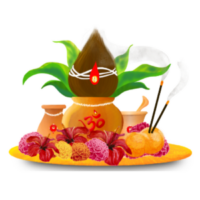?Apara Ekadashi Puja Vidhi?

- Get up in the Brahma Muhurta in the morning, take a bath and wear clean clothes.
- Take a vow to fast while meditating on Lord Vishnu.
- Prepare yellow clothes, a stool, an idol or picture of Lord Vishnu, sandalwood, whole rice, flowers, garland, bhog samagri (basil, fruits, sweets) etc.
- Dress Lord Vishnu and Mother Lakshmi in yellow clothes, apply sandalwood, offer whole rice, garland, offer bhog and light a ghee lamp.
- Chant Vishnu mantras, listen to Ekadashi Vrat Katha, read Vishnu Chalisa and perform Aarti.
- Remain fasting for the whole day and eat fruits in the evening.
- Break the fast the next day in the auspicious muhurta.
***
?Apara Ekadashi Vrat Katha?
The legend surrounding Apara Ekadashi has ancient roots. A gentle and sensible ruler by the name of Mahidhwaj once reigned. Although he was a generous monarch, his younger brother Vajradhwaj was quite different from his older brother. He never liked his brother’s religious demeanor, and he had evil intents against him. He was constantly searching for a chance to murder his brother in order to gain his kingdom and authority. In a dark woodland, he buried his brother’s lifeless body beneath a peepal tree.
But as fate would have it, Mahidhwaj died young, and as a result, his soul became a ghost. He used to roam under the peepal tree with his spirit. People walking through the tree now have headaches from the spirit’s habit of annoying onlookers. One day, while following the same route, a rishi conversed with the king’s ghost. “Why is my soul still wandering?” he asked the king. The sage used his magic to free the king’s spirit and teach him about the afterlife after the ghost told the narrative.
The sage helped the monarch get rid of the pret yoni and kept the fast of Apara Ekadashi for his redemption. He offered the king’s soul the virtue he had acquired by keeping the fast on the day of Dwadashi. The king’s spirit achieves moksha, sheds the pret yoni, and proceeds on his afterlife trip as a result of Apara Ekadashi’s fast.
Hindu mythology and popular belief hold that Lord Krishna told King Yudhishthira about the significance of this Ekadashi. By performing these Ekadashi rites and rituals, one purges past and present transgressions and embarks on a road of positive. The desire for great wealth, notoriety, and social respect is one of the primary motivations for celebrating this Ekadashi. It is also said that by following the Ekadashi rituals with the highest dedication, one may escape this cycle of rebirth and death and arrive at the final gate of moksha.
Those who observe this vrat are thought to receive benefits comparable to those of taking a holy dip in the Ganga during the month of Kartik, according to some religious authorities. On Apar Ekadashi, performing Lord Vishnu’s puja is worth as much in good karma and actions as giving a thousand cows and executing yajnas.
***
